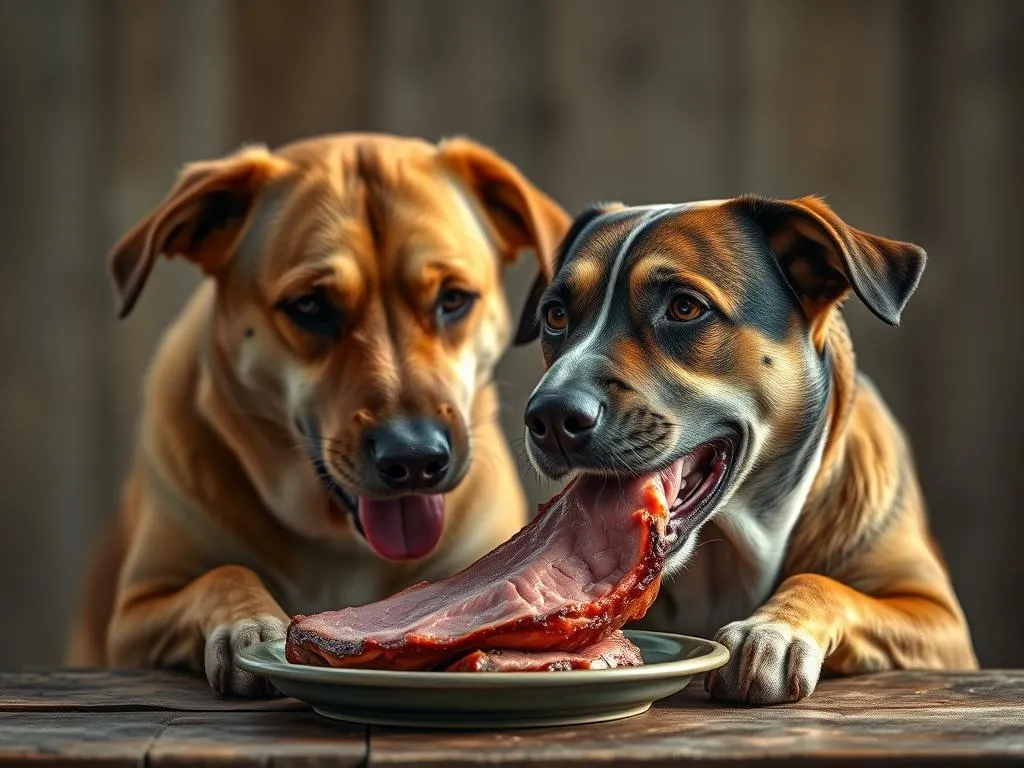
Introduction
Proper dog nutrition is crucial for the overall health and well-being of our furry friends. As pet owners, we often find ourselves pondering what human foods are safe for our dogs to consume. One common question that arises is can dogs eat pork? This article will delve into the safety, benefits, and risks of incorporating pork into a dog’s diet, providing insights to help you make informed decisions.
Understanding Dog Nutrition
Basic nutritional requirements for dogs
To understand whether dogs can eat pork, it’s essential first to grasp their basic nutritional needs. Dogs require a balanced diet that consists of:
- Proteins: Essential for muscle development and tissue repair.
- Fats: Provide energy and support cellular structure.
- Carbohydrates: Serve as a source of energy and aid digestion.
- Vitamins and minerals: Necessary for various bodily functions and overall health.
Role of meat in a dog’s diet
Meat plays a significant role in a dog’s diet, serving as a primary source of:
- Protein: Meat is packed with high-quality protein, which is vital for growth and maintenance.
- Essential fatty acids: These fats support skin and coat health, as well as overall vitality.
- Nutrient absorption: Certain vitamins and minerals are better absorbed when consumed with meat.
Can Dogs Eat Pork?
Overview of pork as a meat option
When considering whether dogs can eat pork, we must examine pork as a meat option. Pork is a popular protein source and can be a safe addition to your dog’s diet when prepared correctly.
Nutritional profile of pork
Pork offers several nutritional benefits, including:
- Protein content: Pork is rich in protein, which is essential for a dog’s muscle development.
- Fat content: While pork contains fats, the type and amount can vary depending on the cut.
- Vitamins and minerals: Pork is a good source of B vitamins, zinc, and iron, which are beneficial for a dog’s health.
Types of pork dogs can eat
When considering feeding pork to your dog, it’s important to know the different forms available:
- Cooked pork: Fully cooked pork, unseasoned and free from harmful additives, is safe for dogs.
- Raw pork: While some advocate for raw feeding, raw pork can pose risks, which we’ll discuss later.
- Processed pork products: Items like bacon and hot dogs are often high in sodium and preservatives, making them less ideal for dogs.
Safety considerations
Feeding pork to your dog requires caution. Here are a few safety considerations:
- Risks of feeding raw pork: Raw pork can harbor harmful bacteria and parasites. Cooking thoroughly eliminates these risks.
- Potential for parasites: Pork may carry parasites such as Trichinella spiralis, which can lead to trichinellosis, a serious illness. Proper cooking is vital to prevent this.
Benefits of Feeding Pork to Dogs
High-quality protein source
One of the primary advantages of feeding pork to dogs is its status as a high-quality protein source. This protein aids in muscle development and overall health, making it an appealing option for many pet owners.
Palatability and taste appeal
Dogs are often drawn to the taste of pork, making it an excellent choice for picky eaters. Its flavor can enhance the overall enjoyment of their meals.
Alternative protein for dogs with allergies
For dogs with allergies or sensitivities to common protein sources like chicken or beef, pork can serve as a beneficial alternative. Introducing pork into their diet may help alleviate allergy-related issues.
Potential for improved coat condition and energy levels
Feeding pork, when done in moderation, can lead to noticeable improvements in a dog’s coat condition and energy levels. The essential fatty acids found in pork contribute to skin health and a shiny coat.
Risks and Concerns of Feeding Pork
Health risks associated with pork
While there are benefits to feeding pork, there are also potential health risks to consider:
- Fatty cuts and obesity: Some pork cuts are fatty, which can contribute to obesity if overfed. Always opt for lean cuts and monitor portion sizes.
- Sodium content in processed pork: Processed pork products often contain high sodium levels, which can be harmful to dogs, especially those with heart issues.
- Potential gastrointestinal issues: Introducing pork too quickly or in large quantities may upset your dog’s stomach, leading to diarrhea or vomiting.
Allergies and intolerances
Some dogs may develop allergies or intolerances to pork. Signs of a pork allergy can include:
- Itchy skin
- Gastrointestinal upset
- Ear infections
If you suspect your dog has a pork allergy, consult with your veterinarian for appropriate alternatives.
Cooking methods and their impact
The way you prepare pork for your dog can significantly affect its safety. Here are some guidelines:
- Safe cooking practices: Always cook pork thoroughly to an internal temperature of at least 145°F (63°C) to kill any harmful bacteria or parasites.
- Avoiding harmful seasonings: Common seasonings like garlic and onion are toxic to dogs. Always serve plain, unseasoned pork.
Guidelines for Feeding Pork to Dogs
Recommended serving sizes
When introducing pork to your dog’s diet, start with small portions. A general rule of thumb is to keep pork as a treat rather than a staple meal. A few ounces, depending on your dog’s size, can be a good starting point.
Frequency of pork in a dog’s diet
Pork should not comprise more than 10% of your dog’s overall diet. Moderation is key to preventing potential health issues associated with overconsumption.
Combining pork with other foods
Consider mixing pork with other dog-safe foods to create a balanced meal. Pairing it with vegetables or grains can enhance nutritional value and provide variety.
Monitoring dog’s reaction to new foods
Always observe your dog after introducing pork into their diet. Watch for any adverse reactions, such as gastrointestinal upset or allergies. If you notice anything unusual, consult your veterinarian.
Conclusion
In summary, the question of can dogs eat pork is multifaceted. Pork can be a nutritious addition to your dog’s diet when prepared and served correctly. It offers several benefits, such as being a high-quality protein source and an alternative for dogs with certain allergies. However, it’s essential to be aware of the health risks associated with feeding pork, especially in its raw or processed forms.
Moderation is key, and it’s crucial to consult with your veterinarian before introducing any new foods. By fostering a balanced and nutritious diet, you can ensure your dog remains healthy and happy.









